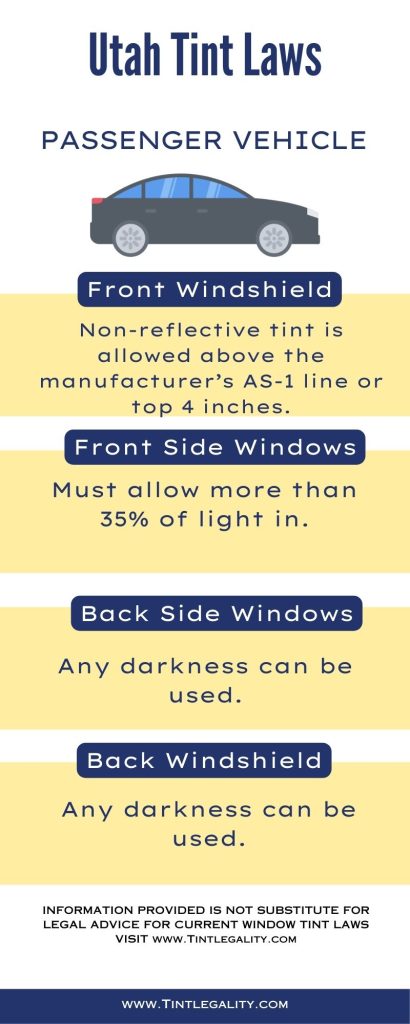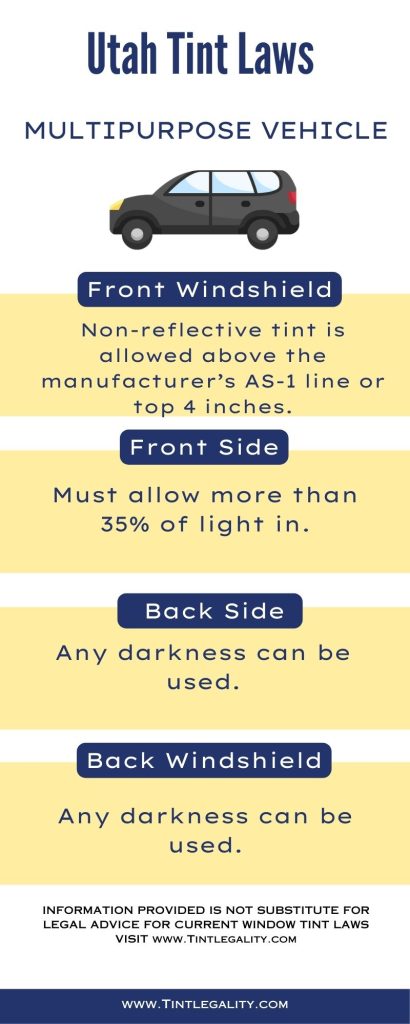Utah tint laws were enacted in 2005. Since then, they’ve been instrumental in providing necessary guidelines for car window tinting.
These rules regulate everything from the level of visible light transmission (VLT) to the extent of tint reflection. Let’s dive in and explore the complexities of these laws.
Utah Window Tint Law
The Utah window tint law caters to different types of vehicles, including sedans, SUVs, and vans.
The key focus of these regulations is the VLT.
VLT represents the percentage of light allowed to filter through the tint film onto the glass.
In the state of Utah, the permissible VLT differs for various vehicle types.
For instance, the darkness for sedans and SUVs or vans is regulated separately.
Let’s go through the specifications for each vehicle category.
Regulations Regarding Window Tint in Utah
| Window | Tint Darkness | Tint Reflection |
|---|---|---|
| Windshield | Non-reflective tint is allowed along the manufacturer’s AS-1 line or the top 4 inches | N/A |
| Front Side Windows | Must allow more than 35% of light in | Mirrored or metallic appearance is allowed |
| Back Side Windows | No limit on the darkness of the tint | Mirrored or metallic appearance is allowed |
| Rear Window | No limit on the darkness of the tint | N/A |
Windshield
For sedans, SUVs, and vans alike, non-reflective tint is permitted along the manufacturer’s AS-1 line or the top 4 inches of the windshield.
Front Side Windows
For these windows, the tint must allow more than 35% light inside the vehicle, according to Utah tint laws.
Back Side Windows and Rear Window
Interestingly, for both sedans and SUVs or vans, there’s no specified limit on the darkness of tint used on the back side and rear windows.


Additional Regulations
Beyond these specific VLT rules, Utah’s tint laws include several other regulations. Let’s delve into some of these additional requirements.
Reflection
The tint on your car windows can reflect incoming light to reduce glare and heat.
In Utah, mirrored or metallic appearances are allowed for both front and back side windows.
Medical Exemptions
In Utah, the tint laws don’t offer medical exemptions that would allow for the use of special tints.
Color Restrictions
Unlike some states, Utah doesn’t restrict tint colors.
Side Mirrors
Utah mandates dual side mirrors if the window behind the driver is tinted.
Exceptions to Legal Limits
Exceptions to these limits do exist, but they are few.
Penalties for Breaking the Law
Breaking Utah’s tint laws is considered a traffic infraction. Penalties for non-compliance include fines and other penalties.
Fines
Fines differ based on the number of convictions.
First Conviction
Upon the first conviction, you will face a certain amount of fine, which can vary based on the extent of the violation.
Second Conviction
If you’re convicted a second time, the fine typically increases, highlighting Utah’s seriousness about enforcing its tint laws.
Third Conviction
A third conviction usually results in an even higher fine.
Other Penalties
Beyond fines, other penalties might also be imposed, like points on your driver’s license or mandatory attendance at a traffic school.
Penalties for Non-Compliance
Non-compliance can also lead to the required removal of non-conforming tint, causing extra inconvenience and cost.
Remember, while we strive to keep this information up-to-date, laws can change, and interpretations can vary by county or place of residence.
Always cross-verify the details with local DMV or law enforcement authorities.
Utah tint laws ensure that your ride is safe and comfortable, while also maintaining the aesthetics of your vehicle.
Stay within the boundaries of these laws to enjoy your journey and avoid unnecessary penalties.
References:
https://en.wikipedia.org/wiki/Utah
https://www.utah.gov/index.html
https://le.utah.gov/xcode/Title41/Chapter6a/41-6a-S1635.html